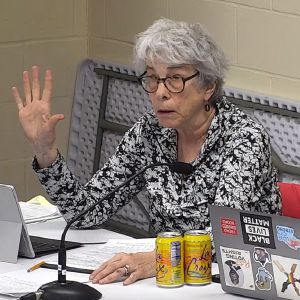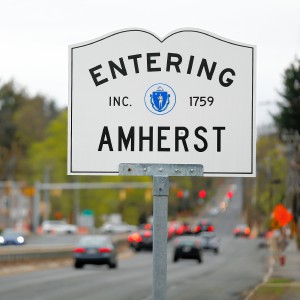Milestone decision for Holyoke: State agrees to turn over control of schools after 9 years of receivership

Holyoke High School. GAZETTE FILE PHOTO
| Published: 10-29-2024 4:50 PM |
HOLYOKE — The end is officially in sight for state receivership of Holyoke’s public schools, a significant achievement that advocates of local control say will have enormous positive impacts on students, educators and families for years to come.
The Massachusetts Department of Elementary and Secondary Education (DESE) agreed Tuesday to enter into a provisional agreement with the state to end nearly a decade of receivership by July 1, 2025 — that is, if the city is able to implement its “capacity building plan.”
Acting DESE commissioner Russell Johnston congratulated Holyoke Mayor Joshua Garcia and Receiver/Superintendent Anthony Soto as the news of the receivership’s pending end was announced.
“I want to be very clear on this — we are very proud of the work that has been done in Holyoke,” said Johnston, who said that students in the city “now benefit from a greatly expanded range of opportunities in the Holyoke Public Schools.”
Garcia noted that the past nine years have been ones of “soul searching” for Holyoke’s leadership, and that the city, and its School Committee, “continues to remain very committed to do what it is that we need to do to prepare for this transition of power,” which is scheduled to be fully approved in June.
Garcia said he is “incredibly proud” for the impact of the news on Holyoke’s history.
Gov. Maura Healey, who approved the provisional decision, called the event “an important step for Holyoke Public Schools,” in a statement Tuesday. Thanking Garcia for his “hard work and partnership,” she added that, “The return to local control will have positive impacts on students, educators and families.”
The state took over control of Holyoke’s schools in 2015, when it designated the city as a “chronically underperforming district” due to low test scores and dropping attendance rates. Receivership, a controversial model, resulted in Holyoke’s School Committee being stripped of its decision-making powers, and in their place a state-designated person was given that authority.
Article continues after...
Yesterday's Most Read Articles
The intention, according to the city’s website, had been to provide Holyoke schools the opportunity for a “significant, sustained turnaround.” Now Holyoke will be the first municipality to transition out of state receivership in Massachusetts. Two other communities, Lawrence and Southbridge, remain in receivership.
Massachusetts Education Secretary Patrick Tutwiler called the decision an “important milestone” for Holyoke.
“I appreciate the progress that Holyoke Public Schools has made to provide students with a high-quality education, including in graduation rates and the use of high-quality instructional materials and evidence-based early literacy practices,” he said.
At Tuesday’s meeting with DESE, Soto laid out a few of the various ways the city has facilitated its turnaround, including introducing higher quality curriculum, exposing teachers to leadership development programs, increasing diversity among staff, and improving school buildings.
“We’ve been able to put our leaders through leadership development to make sure that they are focused on student outcomes, and that they are focused on improving the quality of teaching in our classroom, and have coaches to help support that work,” said Soto, a Holyoke High School graduate himself.
Soto also pointed to a significant investment in capital funding for its school buildings as another important development. When he began his position in 2021, Soto said Holyoke’s schools were “beaten down, broken down, and completely neglected in terms of infrastructure,” but with the help of funding from the Massachusetts School Building Authority, DESE, and the support of the Holyoke City Council, “we’ve made a significant amount of investments in the schools that we have today, over $100 million,” he said.
Other improvements in the district include a drop in the out-of-school suspension rate by 11%, from 20% in 2013 to 9% last year. Full enrollment for vocational education at Holyoke High School Dean Campus was reported in the 2021-2022 school year, after a decade of under-enrollment.
Additionally, increases in access for high school students taking advanced coursework (up from 40% in 2018 to 55% this year), and more resources for dual-language programs have expanded over this time period.
All this, said Soto, is “a testament of the hard work” of Holyoke’s teachers, leadership, and community members, as graduation rates have climbed 14 points — from 60.2% in 2014, to 74.6% in 2023.
Other improvements include redesigning Holyoke High School to offer a Freshman Academy for a more personalized entry to high school, as well as theme-based academies and career vocational technical education pathways designed to ignite student interest and connect learning to the real world; full enrollment in the career vocational technical education pathways at the Holyoke High School Dean Campus since the 2021-22 school year, after nearly a decade of under-enrollment; and rezoning of the district into separate elementary and middle schools, supported by the construction of a new middle school that is scheduled to open in the fall of 2025.
Going forward, a strategic improvement plan, compiled by the Holyoke School Committee’s Local Control Subcommittee and DESE this past summer, will guide Holyoke school leadership as they regain independence. A final decision will be reached in June concerning the receivership status, if Johnston determines Holyoke has been able to effectively implement its capacity building plan.
That plan, previously approved on Aug. 19 after seven meetings from April to August, is a process that will empower the Holyoke School Committee “so that they are solidly in place for governance when this provisional period ends,” Johnston stated.
Objectives in the plan are hiring and evaluating a superintendent, establishing budgeting and finances, and developing policy for the School Committee.
“This plan helps to bridge that gap between the knowledge and investment and learning that they’ve created for themselves, the training that they’ve invested in, and now putting that into action during this transitional period,” said Johnston, who added that he has “great hope for the future of Holyoke.”
Both Garcia and Soto also shared the significance of this move for them as Holyoke natives, introducing themselves as proud “products” of Holyoke’s schools. Soto shared that Holyoke has “contributed to the man I am today,” adding that the work of the past nine years has been “really personal.”
Both Holyoke officials thanked members of the community for making the receivership a successful period for Holyoke.
Garcia praised School Committee members, who have “consistently met every single month, every year since being in receivership.” In addition, he expressed gratitude to Healy, Johnston and DESE, and the state for their support and being “extremely patient through this process.”
“Although this is welcoming news, we certainly do not take it at all very lightly. We understand that there is still so much work to do,” said Garcia.
Samuel Gelinas can be reached at sgelinas@gazettenet.com.






 Community printing hub takes shape in Easthampton
Community printing hub takes shape in Easthampton Northampton School Committee backs ‘strong’ budget, while acknowledging they likely won’t get it
Northampton School Committee backs ‘strong’ budget, while acknowledging they likely won’t get it Amherst Town Council calls emergency meeting to consider rescinding funds for Jones Library project
Amherst Town Council calls emergency meeting to consider rescinding funds for Jones Library project Amherst Town Council approves University Drive overlay district
Amherst Town Council approves University Drive overlay district
